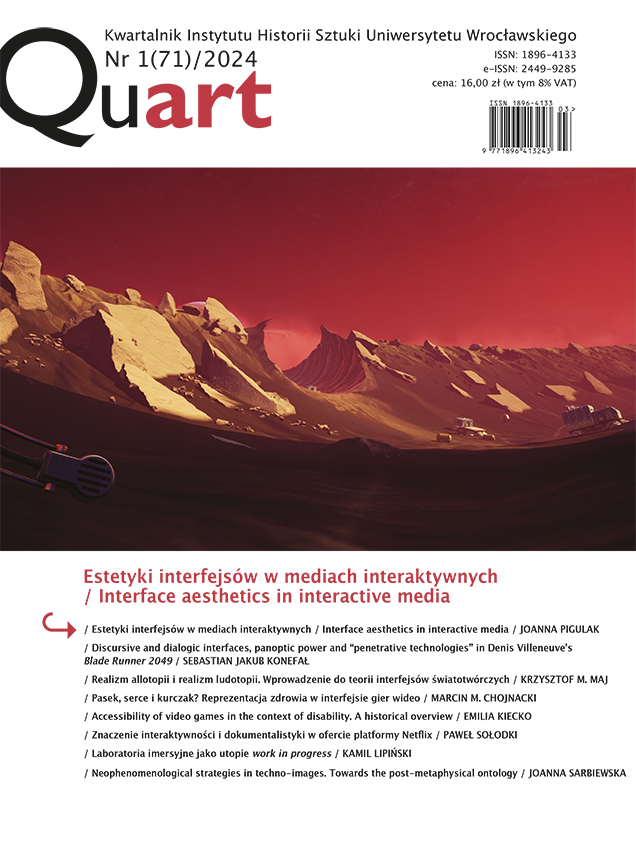

Artykuły

Denis Villeneuve’s Blade Runner 2049 (2017) is a culture text that, in many scenes, creatively uses visualisations of futuristic machine interfaces designed to scan and penetrate realms inaccessible to humans. Many of these devices can be interpreted from the perspective of Vilém Flusser’s research on discursive and dialogic technologies. The former, according to the philosopher, serve to enslave individuals, while the latter as emancipatory gestures. The universe presented in Villeneuve’s film has the characteristics of a panoptic dystopia, in which knowledge is an element of strengthening corporate and state power. The discursive technologies associated with panoptic power, and their interfaces and functionaries, are here vested with the mission of finding and archiving data lost in a catastrophic incident to reinforce the oppressive order. The agent of telemetric upheaval, on the other hand, is the main character – the posthuman, who turns out by the end of the plot to be the personification of the idea of a dialogical interface – which can serve the homo sapiens with his cognitive abilities to discover inaccessible truths, enabling them to find a symbiotic way of humanity’s existence with its technological creations and opening up to the Other.
Barcz Anna, Przedmioty ekozagłady. Spekulatywna teoria hiperobiektów Timothy’ego Mortona i jej (możliwe) ślady w literaturze, “Teksty Drugie” 2018, No. 2.
Bruno Giuliana, Ramble City: Postmodernism and “Blade Runner”, “October” 1987, No. 2.
Celiński Piotr, Biomedia i antropologia gestów i ciała, [in:] Vilém Flusser i kultura mediów, Ed. P. Wiatr, M. Sanakiewicz, Lublin 2021.
Derrida Jacques, Gorączka archiwum. Impresja freudowska, Transl. J. Momro, Warszawa 2016.
Eszenyi Peter, Portfolio, https://petereszenyi.com/portfolio/blade-runner-2049 (access date: 21.12.2023).
Failes Ian, A Visual Journey through the Screen Graphics of “Blade Runner 2049”, https://vfxblog.com/2017/11/08/a-visual-journey-through-the-screen-graphics-of-blade-runner-2049 (access date: 21.12.2023).
Flusser Vilém, Człowiek jako podmiot lub projekt, [in:] idem, Kultura pisma. Z filozofii słowa i obrazu, Transl., Afterw. P. Wiatr, Warszawa 2018.
Flusser Vilém, Into the Universe of Technical Images, Transl. N. A. Roth, Introd. M. Poster, Minneapolis 2011.
Frelik Paweł, The Future of the Past: Science Fiction, Retro, and Retrofuturism, [in:] Parabolas of Science Fiction, Ed. B. Attebery, V. Hollinger, Middletown (Connecticut) 2013.
Frelik Paweł, NeoCYBERliberalPUNKizm – polityka i ideologia cyberpunka, “Teksty Drugie” 2021, No. 6.
Foucault Michel, Nadzorować i karać. Narodziny więzienia, Transl. T. Komendant, Warszawa 2020.
Hudzik Agnieszka, Od społeczeństwa telematycznego do retrotopicznej wspólnoty plemiennej. O filmie Zbigniewa Libery “Walser” (2015), [in:] Vilém Flusser i kultura mediów, Ed. P. Wiatr, M. Sanakiewicz, Lublin 2021.
Kostyszak Maria, Istota techniki. Głos Martina Heideggera, Wrocław 1998.
Lapointe Tanya, Blade Runner 2049: Interlined: The Art, London 2020.
Lunenfeld Peter, Generacje: jak komputer stał się maszyną generującą kulturę, [in:] Mindware. Technologie dialogu, Ed. P. Celiński, Lublin 2012.
RocketStock, The Near-Future Design and Surprising Influences behind Sci-Fi UI, https://blog.pond5.com/54667-computer-screen-design-territory-films (access date: 21.12.2023).
Shadbolt Nigel, Smart Paul, The Eyes of God, [in:] “Blade Runner 2049”: A Philosophical Exploration, Ed. T. Shanahan, P. Smart, London – New York 2020.
Summers Nick, Designing the Technology of “Blade Runner 2049”, https://www.engadget.com/2017-10-20-designing-the-technology-of-blade-runner-2049.html (access date: 21.12.2023).
Marshall Kingsley, Mere Data Makes a Man: Artificial Intelligences in “Blade Runner 2049”, [in:] ReFocus: The Films of Denis Villeneuve, Ed. J. English, M. Pascal, Edinburgh 2023.
Morton Tymothy, Hyperobjects: Philosophy and Ecology after the End of the World, Minneapolis–London 2013.
Wegner Philip E., We, the People of “Blade Runner 2049”, “Science Fiction Film & Television” 2020, No. 1.
Wiatr Przemysław, W poszukiwaniu Innego – Vilém Flusser i życie dialogiczne, [in:] Vilém Flusser i kultura mediów, Ed. P. Wiatr, M. Sanakiewicz, Lublin 2021.
Yuen Jono, “Blade Runner 2049” – UI Design, https://www.hudsandguis.com/home/2018/blade-runner-2049 (access date: 21.12.2023).
Zawojski Piotr, Człowiek i aparat. Viléma Flussera filozofia fotografii, http://www.zawojski.com/2006/04/19/czlowiek-i-aparat-vilema-flussera-filozofia-fotografii (access date: 21.12.2023).